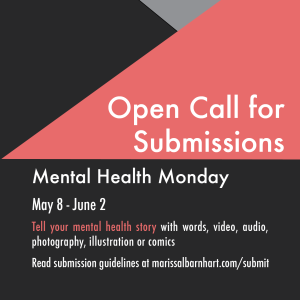
In honor of Mental Health Awareness Month, every Monday, Wednesday and Friday in May, I’ll be breaking down the basics of mental illnesses you said you wanted to read more about.
Read about: PTSD
Mental Health Monday will also accept submissions to be featured throughout the month, whether writing, art, photo, audio, video etc. Narratives and creative pieces are welcome. If you’d like to learn more, message me on Facebook or Twitter or email at mleibarnhart@gmail.com. You can read Submission Guidelines Here.
Obsessive-Compulsive Disorder
Obsessive-Compulsive Disorder (OCD) is a disorder in which a person becomes caught in a loop of obsessions and compulsions, including unwanted, intrusive thoughts, habits and rituals.
The National Institute of Mental Health defines OCD as “a common, chronic and long-lasting disorder in which a person has uncontrollable, recurring thoughts (obsessions) and behaviors (compulsions) that he or she feels the urge to repeat over and over.”
Obsessive-compulsive disorder can affect anyone of any age, and according to Beyond OCD, approximately 1 in 40 American adults, and 1 in 100 children, have it.
There are two main components of obsessive-compulsive disorder: obsessions and compulsions.
Obsessions are repetitive thoughts, images and impulses that uncontrollably occur. These thoughts usually trigger stress responses such as anxiety and fear. Some obsessions might include fear of germs or bacteria, intense organization and intrusive aggressive or sexual thoughts.
Compulsions are repetitive rituals that people use to counteract the fear and anxiety caused by obsessive thoughts. For example, if someone has a fear of germs, their compulsion might be to excessively wash their hands.
For a full list of common obsessions and compulsions, please visit the International OCD Foundation.
Spoken word artist Neil Hilborn performed a piece titled “OCD,” in which he describes how his mental illness has affected his relationship. He says, “I asked her out six times in 30 seconds. She said yes after the third one, but none of them felt right so I had to keep going.” As he continues, what was patience and understanding turns into annoyance and his partner eventually leaving. It’s important to remember that mental illness is an illness. It’s not a charming quirk that can be romanticized. Listen to Hilborn’s “OCD” below:
Getting Help
Obsessions and compulsions aren’t something that a person with OCD can just “turn off.” For people without OCD, it’s typically easy to push out invasive thoughts and focus on other tasks. But people living with the disorder can spend hours obsessing or performing a ritual, and it becomes detrimental to their daily functioning.
People with obsessive-compulsive disorder are aware that their thoughts and compulsions are irrational but feel powerless against them.
But it is treatable.
As of now, a lab test for OCD doesn’t exist, but mental health professionals use a series of diagnostic interviews and other tools, such as the Yale-Brown Obsessive Compulsive Scale (Y-BOCS), to determine the presence of severity of the disorder.
If you or someone you know might show signs of OCD, please seek the help of a mental health professional. If you are a college student, research mental health services at your university. If you are under the age of 18, please reach out to a trusted adult for help.
For help finding a therapist, visit:
National Alliance on Mental Health
Psychology Today
Good Therapy
For more on obsessive-compulsive disorder, visit:
Beyond OCD
National Institute of Mental Health
International OCD Foundation

[…] Read about: PTSD | OCD […]
LikeLike
[…] about: PTSD | OCD | Bipolar […]
LikeLike